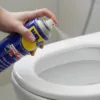WD-40 is that miracle spray that is found in almost every household. It can be used to eliminate annoying squeaky doors, loosen rusty screws, and even clean stains from various surfaces. But did you know that most people use WD-40 completely wrong?
Many users think that WD-40 is a universal lubricant that can be applied anywhere, anytime. But that's not true! In fact, WD-40 is water repellent, developed primarily for rust protection and moisture removal. And although it has some lubricating properties, it is not suitable for long-term lubrication.
If used incorrectly, it can even worsen the condition of metal parts, damage certain materials, or cause dirt to accumulate more quickly. So that you can use it in the future WD-40 used As is necessary, we have prepared detailed instructions on what to do – and what not to do!
WD-40 is not a regular lubricant – so what is it?
WD-40 is an abbreviation for "Water Displacement – 40th formula", meaning it was originally developed to remove moisture and protect metals from rust. It was created in 1953 for use in the aerospace industry, but only later became an indispensable household item.
The main feature of WD-40 is that prevents rust, loosens rusty parts and cleans dirt, but it does not lubricate surfaces for a long time. If you use it to lubricate chains, locks or hinges, you will quickly find that after a few days these parts become even drier and start to squeak faster!

Now that you know that WD-40 is more than just a lubricant, let's look at how to use it properly to truly harness its power.
5 key rules for using WD-40 correctly
1. Do not use it as a permanent lubricant!
Many people assume that WD-40 is ideal for lubricating all moving parts – from door hinges to bicycle chains. In fact, only works for a short timeWhen applied, it creates a thin layer that temporarily reduces friction. However, it evaporates over time and also attracts dust and dirt, which can even impair the operation of certain mechanisms.
Correct use:
- Use it for releasing stuck or rusty parts.
- Wipe it off after use and apply the right lubricant, such as lithium grease or silicone.
- Do not use it on wheel chains, hinges or bearingswhere you need long-lasting lubrication.
2. Always clean the surface before application
WD-40 does not work optimally if applied to a dirty or oily surface. If you spray it directly on a rusty bolt surrounded by dust and mud, it will not penetrate the rust, as the dirt will prevent its effect.
Correct use:
- Before application, the surface clean with a dry cloth or old toothbrush.
- If there is grease on the surface, remove it with rubbing alcohol or detergent.
- After application, wait a few minutes and then wipe off excess liquid.
3. Wait for it to start working
Most people spray WD-40 and immediately try to loosen a rusty bolt or loosen a stuck part. But WD-40 takes time to penetrate deep into the rusted structure and loosen the bond between metal parts.
Correct use:
- After application wait at least 10–15 minutesbefore you start unscrewing the screw.
- If the screw is heavily rusted, leave it on overnight and spray it several times.
- Use it small hammerto help the WD-40 penetrate deeper with light strokes.
4. Do not use it on electrical components
Although WD-40 repels moisture, you should not apply it directly to electrical contacts, circuits, or the inside of electronics because leaves a greasy residue, which may cause a short circuit or damage the circuit.
Correct use:
- If you need to remove moisture from an electrical device, use a special electrical contact spray.
- You can use it on external parts of electrical devicesto protect them from rust.
- Never use it on computer components, sockets or inside engines.
5. Use it in moderation
More WD-40 does not mean better. If you over-saturate the surface, the residue will attract more dirt, causing wear and tear or even corrosion.
Correct use:
- Always apply thin layer and add a little more if necessary.
- If you use it on rusty screws, use a tubeto direct the spray directly into the crack.
- After use wipe off excessto prevent dirt from accumulating.

Where can you safely use WD-40?
- Rust removal from metal surfaces
- Loosening rusty screws and locks
- Preventing locks from freezing
- Removing glue residue from stickers
- Cleaning rubber seals in cars
Preventing rust on tools
Where should you not apply it?
- Electrical components
- Wheel chains and bearings
- The inside of car locks
If you've been using it wrong so far, don't panic! Now you know how to use it correctly to make it truly effective.






